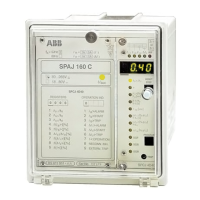9
Programming
switches
Additional functions required by individual
applications are selected by means of the
switchgroups SGF, SGB1...3 and SGR1...3 in-
dicated on the front panel. The numbering of
the switches, 1...8, and the switch positions, 0
and 1, are indicated when the switchgroups are
being set. In normal service only the checksums
are shown.
Functional switch-
group SGF/1 to
SGF/8
Switch Function Factory
setting
SGF/1 The overload stage I
a
> can be linked to tripping relay TS2 by means of 0
this switch
When SGF/1=0, the overload stage I
a
> is not linked to TS2
When SGF/1=1, the overload stage I
a
> is linked to TS2
SGF/2 The undercurrent stage I< can be linked to tripping relay TS2 by means 0
of this switch
When SGF/2=0 the undercurrent stage I< is not linked to TS2
When SGF/2=1 the undercurrent stage I< is linked to TS2
SGF/3 Switches SGF/3...4 are used for selecting the mode of operation of the 0
SGF/4 start indicators of the different stages. When the switches are in position 0
0 the start indicators are all automatically reset when the fault is cleared.
In order to get a hand reset start indication for the stages, their respective
switches have to be in position 1:
When SGF/3=1, the start indicator of the overload stage I
b
> is to be
manually reset
When SGF/4=1, the start indicator of the unbalance stage ∆I
2
> is to be
manually reset
SGF/5 The reconnection inhibit output can be disabled by means of this switch 0
Note! This switch is only to be used if the module SPCJ 4D40 is used
elsewere than in SPAJ 160 C.
When SGF/5=0, the reconnection inhibit relay is in use
When SGF/5=1, the reconnection inhibit relay is disabled
SGF/6 Increase the inverse time characteristic for phase unbalance stage ∆I
2
>0
by a factor 10.
When SGF/6 = 1 increase the inverse time by a factor 10.
This feature has been implemented from the program version 081 C
and later versions.
SGF/7 Reserved for future use 0
SGF/8 Reserved for future use 0

